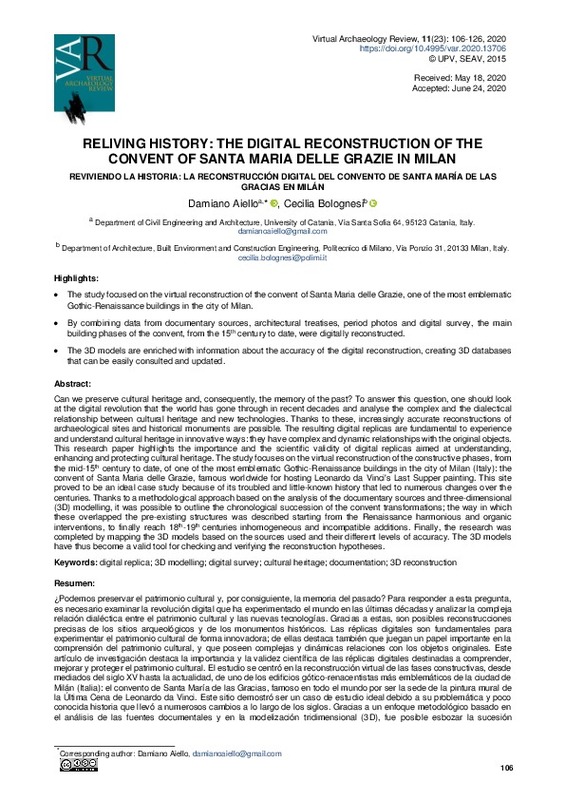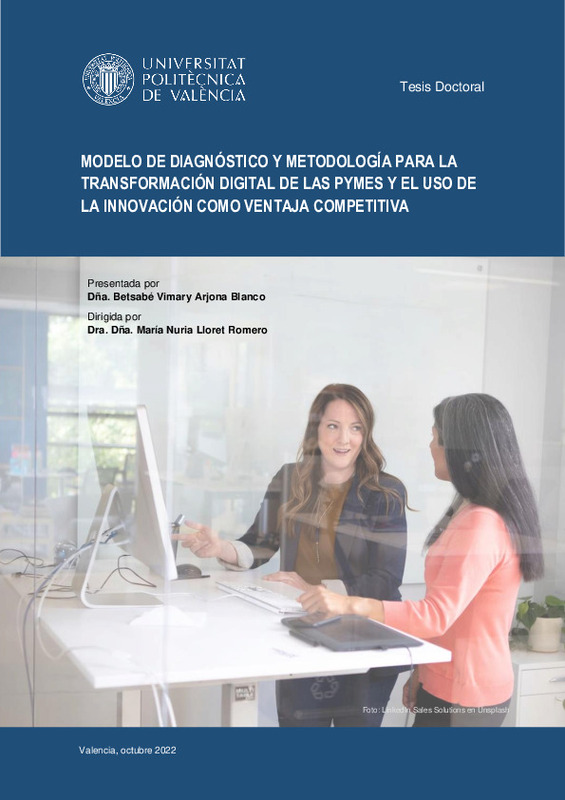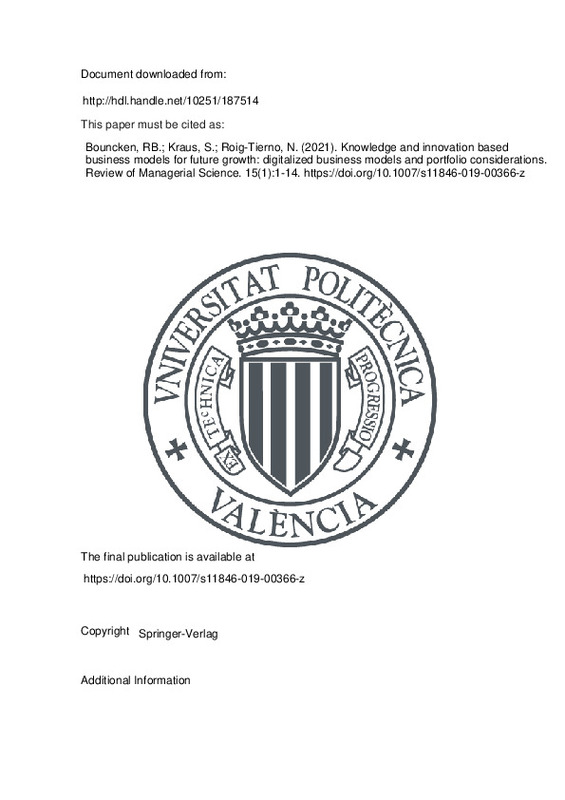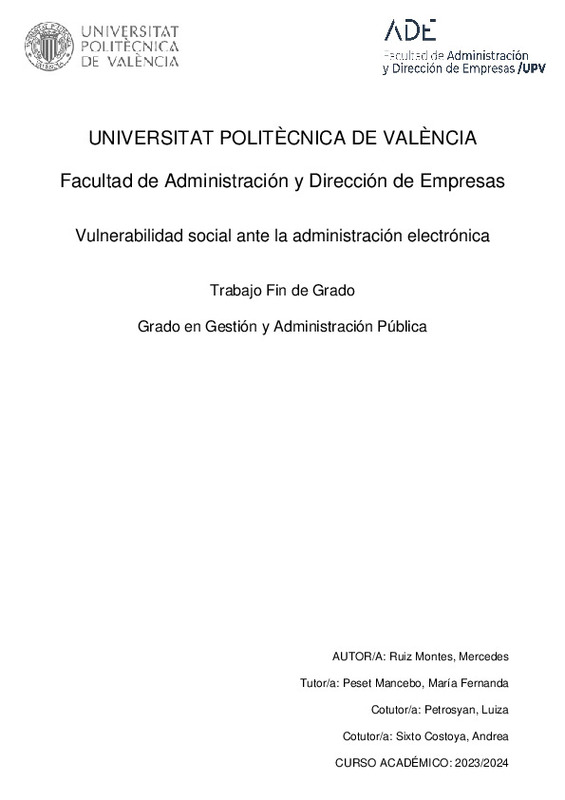JavaScript is disabled for your browser. Some features of this site may not work without it.
Buscar en RiuNet
Listar
Mi cuenta
Estadísticas
Ayuda RiuNet
Admin. UPV
Reliving history: the digital reconstruction of the convent of Santa Maria delle Grazie in Milan
Mostrar el registro sencillo del ítem
Ficheros en el ítem
| dc.contributor.author | Aiello, Damiano
|
es_ES |
| dc.contributor.author | Bolognesi, Cecilia
|
es_ES |
| dc.coverage.spatial | east=9.1703603; north=45.4660696; name=Piazza di Santa Maria delle Grazie, 1, 20123 Milano MI, Itàlia | es_ES |
| dc.date.accessioned | 2020-07-16T10:24:14Z | |
| dc.date.available | 2020-07-16T10:24:14Z | |
| dc.date.issued | 2020-07-08 | |
| dc.identifier.uri | http://hdl.handle.net/10251/148115 | |
| dc.description.abstract | [EN] Can we preserve cultural heritage and, consequently, the memory of the past? To answer this question, one should look at the digital revolution that the world has gone through in recent decades and analyse the complex and the dialectical relationship between cultural heritage and new technologies. Thanks to these, increasingly accurate reconstructions of archaeological sites and historical monuments are possible. The resulting digital replicas are fundamental to experience and understand cultural heritage in innovative ways: they have complex and dynamic relationships with the original objects. This research paper highlights the importance and the scientific validity of digital replicas aimed at understanding, enhancing and protecting cultural heritage. The study focuses on the virtual reconstruction of the constructive phases, from the mid-15th century to date, of one of the most emblematic Gothic-Renaissance buildings in the city of Milan (Italy): the convent of Santa Maria delle Grazie, famous worldwide for hosting Leonardo da Vinci's Last Supper painting. This site proved to be an ideal case study because of its troubled and little-known history that led to numerous changes over the centuries. Thanks to a methodological approach based on the analysis of the documentary sources and three-dimensional (3D) modelling, it was possible to outline the chronological succession of the convent transformations; the way in which these overlapped the pre-existing structures was described starting from the Renaissance harmonious and organic interventions, to finally reach 18th -19th centuries inhomogeneous and incompatible additions. Finally, the research was completed by mapping the 3D models based on the sources used and their different levels of accuracy. The 3D models have thus become a valid tool for checking and verifying the reconstruction hypotheses. | es_ES |
| dc.description.abstract | [ES] ¿Podemos preservar el patrimonio cultural y, por consiguiente, la memoria del pasado? Para responder a esta pregunta, es necesario examinar la revolución digital que ha experimentado el mundo en las últimas décadas y analizar la compleja relación dialéctica entre el patrimonio cultural y las nuevas tecnologías. Gracias a estas, son posibles reconstrucciones precisas de los sitios arqueológicos y de los monumentos históricos. Las réplicas digitales son fundamentales para experimentar el patrimonio cultural de forma innovadora; de ellas destaca también que juegan un papel importante en la comprensión del patrimonio cultural, y que poseen complejas y dinámicas relaciones con los objetos originales. Este artículo de investigación destaca la importancia y la validez científica de las réplicas digitales destinadas a comprender, mejorar y proteger el patrimonio cultural. El estudio se centró en la reconstrucción virtual de las fases constructivas, desde mediados del siglo XV hasta la actualidad, de uno de los edificios gótico-renacentistas más emblemáticos de la ciudad de Milán (Italia): el convento de Santa María de las Gracias, famoso en todo el mundo por ser la sede de la pintura mural de la Última Cena de Leonardo da Vinci. Este sitio demostró ser un caso de estudio ideal debido a su problemática y poco conocida historia que llevó a numerosos cambios a lo largo de los siglos. Gracias a un enfoque metodológico basado en el análisis de las fuentes documentales y en la modelización tridimensional (3D), fue posible esbozar la sucesión cronológica de las transformaciones; se trabajó desde las intervenciones armoniosas y orgánicas del renacimiento, hasta alcanzar las adiciones desiguales e incompatibles de los siglos XVIII y XIX. Por último, la investigación se completó con el mapeado de los modelos 3D sobre la base de las fuentes utilizadas y sus diferentes niveles de precisión. Los modelos 3D se han convertido así en un instrumento válido para comprobar y verificar las hipótesis reconstructivas. | es_ES |
| dc.language | Inglés | es_ES |
| dc.publisher | Universitat Politècnica de València | es_ES |
| dc.relation.ispartof | Virtual Archaeology Review | es_ES |
| dc.rights | Reconocimiento - No comercial - Sin obra derivada (by-nc-nd) | es_ES |
| dc.subject | Digital replica | es_ES |
| dc.subject | 3D modelling | es_ES |
| dc.subject | Digital survey | es_ES |
| dc.subject | Cultural heritage | es_ES |
| dc.subject | Documentation | es_ES |
| dc.subject | 3D reconstruction | es_ES |
| dc.subject | Réplica digital | es_ES |
| dc.subject | Modelado 3D | es_ES |
| dc.subject | Levantamiento digital | es_ES |
| dc.subject | Patrimonio cultural | es_ES |
| dc.subject | Documentación | es_ES |
| dc.subject | Reconstrucción 3D | es_ES |
| dc.title | Reliving history: the digital reconstruction of the convent of Santa Maria delle Grazie in Milan | es_ES |
| dc.title.alternative | Reviviendo la historia: la reconstrucción digital del convento de Santa María de las Gracias en Milán | es_ES |
| dc.type | Artículo | es_ES |
| dc.identifier.doi | 10.4995/var.2020.13706 | |
| dc.rights.accessRights | Abierto | es_ES |
| dc.description.bibliographicCitation | Aiello, D.; Bolognesi, C. (2020). Reliving history: the digital reconstruction of the convent of Santa Maria delle Grazie in Milan. Virtual Archaeology Review. 11(23):106-126. https://doi.org/10.4995/var.2020.13706 | es_ES |
| dc.description.accrualMethod | OJS | es_ES |
| dc.relation.publisherversion | https://doi.org/10.4995/var.2020.13706 | es_ES |
| dc.description.upvformatpinicio | 106 | es_ES |
| dc.description.upvformatpfin | 126 | es_ES |
| dc.type.version | info:eu-repo/semantics/publishedVersion | es_ES |
| dc.description.volume | 11 | es_ES |
| dc.description.issue | 23 | es_ES |
| dc.identifier.eissn | 1989-9947 | |
| dc.relation.pasarela | OJS\13706 | es_ES |
| dc.description.references | Addison, A. C., 2001. Virtual heritage: technology in the service of culture. In VAST '01 Proceedings of the 2001 conference on virtual reality, archaeology, and cultural heritage (pp. 343-354). New York (USA): Association for Computing Machinery. https://doi.org/10.1145/584993.585055 | es_ES |
| dc.description.references | Affleck, J., Kalay, Y., & Kvan, T. (2008). New Heritage: New Media and Cultural Heritage. New York, New York: Routledge. https://doi.org/10.4324/9780203937884 | es_ES |
| dc.description.references | Aiello, D., Fai, S., & Santagati, C. (2019). Virtual museums as a means for promotion and enhancement of cultural heritage. International Archives of the Photogrammetry, Remote Sensing and Spatial Information Sciences, XLII-2/W15, 33-40. https://doi.org/10.5194/isprs-archives-XLII-2-W15-33-2019 | es_ES |
| dc.description.references | Arnold, D., & Geser, G. (2008). Research Agenda for the Applications of ICT to Cultural Heritage. Full Report. EPOCH. Budapest: Archaeolingua 2008. http://public-repository.epoch-net.org/publications/RES_AGENDA/research_agenda.pdf | es_ES |
| dc.description.references | AAVV. (1983). Santa Maria delle Grazie. Cinisello Balsamo: Amilcare Pizzi Arti Grafiche. Banca Popolare Di Milano. | es_ES |
| dc.description.references | Banfi, F.; Brumana, R., & Stanga, C. (2019). Extended reality and informative models for the architectural heritage: from scan-to-BIM process to virtual and augmented reality. Virtual Archaeology Review, 10(21), 14-30. https://doi.org/10.4995/var.2019.11923 | es_ES |
| dc.description.references | Barozzi da Vignola, J. (1732). Regola delli cinque ordini d'Architettura. Roma: G. Zempel. | es_ES |
| dc.description.references | Beale, G. (2018). Volatile images: authenticity and representation and multi-vocality in digital archaeology. In P. Di Giuseppantonio Di Franco, F. Galeazzi, & V. Vassallo (Eds.), Authenticity and cultural heritage in the age of 3D digital reproductions (pp. 83-94). Cambridge (UK): McDonald Institute for Archaeological Research. https://doi.org/10.17863/CAM.27029 | es_ES |
| dc.description.references | Benjamin, W. (1968). Illuminations. New York: Schocken Books. | es_ES |
| dc.description.references | Boezia, E. (2018). Ektypa and 3D models of Ektypa: the reality(ies) of a digital object. In P. Di Giuseppantonio Di Franco, F. Galeazzi, & V. Vassallo (Eds.), Authenticity and cultural heritage in the age of 3D digital reproductions (pp. 97-110). Cambridge (UK): McDonald Institute for Archaeological Research. https://doi.org/10.17863/CAM.27029 | es_ES |
| dc.description.references | Bolognesi, C., & Aiello, D. (2019). From Digital Survey to a Virtual Tale: Virtual Reconstruction of the Convent of Santa Maria delle Grazie in Milan. In C. Bolognesi, C. Santagati (Eds.), Impact of Industry 4.0 on Architecture and Cultural Heritage (pp. 49-75). Hershey, Pennsylvania (USA): IGI GLOBAL. https://doi.org/10.4018/978-1-7998-1234-0.ch001 | es_ES |
| dc.description.references | Brogi, S (n.d.). Milano - Santa Maria delle Grazie, interno, Cenacolo. Retrived from http://www.lombardiabeniculturali.it/fotografie/schede/IMM-3a280-0000048/ Last accessed 10/05/2020. | es_ES |
| dc.description.references | Bruschi, A. (1983). L' Architettura. In AAVV, Santa Maria delle Grazie in Milano (pp. 35-89). Milano: Banca Popolare di Milano. | es_ES |
| dc.description.references | Demetrescu, E. (2018). Virtual reconstruction as a scientific tool: The Extended Matrix and source-based modelling approach. In S. Münster, K. Friedrichs, F. Niebling, A. Seidel-Grzesińska (Eds.), Digital Research and Education in Architectural Heritage: 5th Conference, DECH 2017, and First Workshop, UHDL 2017, Dresden, Germany, March 30-31, 2017, Revised Selected Papers (pp. 102-116). Cham (CH): Springer. http://osiris.itabc.cnr.it/extendedmatrix/wp-content/uploads/2015/08/Demetrescu-2018-Virtual-Reconstruction.pdf https://doi.org/10.1007/978-3-319-76992-9_7 | es_ES |
| dc.description.references | Denker, A. (2017). Rebuilding Palmyra virtually: Recreation of its former glory in digital space. Virtual Archaeology Review, 8(17), 20-30. https://doi.org/10.4995/var.2017.5963 | es_ES |
| dc.description.references | Dhanda, A., Reina Ortiz, M., Weigert, A., Paladini, A., Min, A., Gyi, M., Su, S., Fai, S., & Santana Quintero, M., 2019. Recreating cultural heritage environments for VR using photogrammetry. International Archives of the Photogrammetry, Remote Sensing and Spatial Information Sciences, XLII-2/W9, 305-310. https://doi.org/10.5194/isprs-archives-XLII-2-W9-305-2019 | es_ES |
| dc.description.references | Forte, M., Pescarin, S., & Pujol, L. (2006). VR applications, new devices and museums: visitors' feedback and learning. A preliminary report. in The e-volution of information technology in Cultural Heritage. Where hi-tech touches the past: risks and challenges for the 21st century. Proceedings of the 7th International Symposium on Virtual Reality, Archaeology and Cultural Heritage, Vast 2006 (pp. 64-69). Nicosia, Cyprus: Eurographics. | es_ES |
| dc.description.references | Forte, M. (2008). La villa di Livia, un percorso di ricerca di archeologia virtuale. Roma: Erma di Bretschneider. 10.13140/2.1.2107.4887 | es_ES |
| dc.description.references | Forte, M., (2014). 3D Archaeology. New perspectives and challenges. The example of Çatalhöyük. Near Eastern Archaeology 2, 1-29. https://doi.org/10.13140/2.1.3285.0568 | es_ES |
| dc.description.references | Garstki, K. (2018). Virtual authority and the expanding role of 3D digital artefacts. In P. Di Giuseppantonio Di Franco, F. Galeazzi, & V. Vassallo (Eds.), Authenticity and cultural heritage in the age of 3D digital reproductions (pp. 75-81). Cambridge (UK): McDonald Institute for Archaeological Research. https://doi.org/10.17863/CAM.27029 | es_ES |
| dc.description.references | Gattico, G. (2004). Descrizione succinta e vera delle cose spettanti alla chiesa e convento di Santa Maria delle Grazie e di Santa Maria della Rosa e suo luogo, et altre loro aderenze in Milano dell'Ordine de'predicatori con due tavole infine. Milano: Castello Sforzesco Ente Raccolta Vinciana. | es_ES |
| dc.description.references | Jeffrey, S. (2018). Digital heritage objects, authorship, ownership and engagement. In P. Di Giuseppantonio Di Franco, F. Galeazzi, & V. Vassallo (Eds.), Authenticity and cultural heritage in the age of 3D digital reproductions (pp. 49-56). Cambridge (UK): McDonald Institute for Archaeological Research. https://doi.org/10.17863/CAM.27029 | es_ES |
| dc.description.references | Jeffrey, S., Hale, A., Jones, C., Jones, S., & Maxwell, M. (2015). The ACCORD project: Archaeological Community Co-Production of Research Resources. In F. Giligny, F. Djindjian, L. Costa, P. Moscati, & S. Robert (Eds.), Proceedings of the 42nd Annual Conference on Computer Applications and Quantitative Methods in Archaeology (pp. 289-295). Oxford: Archaeopress Archaeology. https://doi.org/10.5284/1042733 | es_ES |
| dc.description.references | Jones, S. (2010). Negotiating authentic objects and authentic selves: beyond the deconstruction of authenticity. Journal of Material Culture, 15(2), 181-203. https://doi.org/10.4324/9780203165744 | es_ES |
| dc.description.references | Joy, J. (2002). Biography of a Medal: People and Things They Value. In J. Schofield, W. Gray Johnson, & C.M. Beck (Eds.), Material Culture: The Archaeology of Twentieth Century Conflict (pp. 132-142). London: Routledge. https://doi.org/10.4324/9780203165744 | es_ES |
| dc.description.references | Kargas, A., Loumos, G., & Varoutas, D. (2019). Using different ways of 3D reconstruction of historical cities for gaming purposes: the case study of Nafplio. Heritage, 2(3), 1799-1811. https://doi.org/10.3390/heritage2030110 | es_ES |
| dc.description.references | Latour, B., & Lowe, A. (2011). The Migration of the Aura or How to Explore the Original through Its Facsimiles. In T. Bartscherer & R. Coover (Eds.), Switching Codes. Chicago: The University of Chicago Press. | es_ES |
| dc.description.references | Manžuch, Z. (2017). Ethical issues in digitization of cultural heritage. Journal of Contemporary Archival Studies, 4, 4. | es_ES |
| dc.description.references | Martelli, G. (1981). Il refettorio di Santa Maria delle Grazie in Milano e il restauro di Luca Beltrami nell'ultimo decennio dell'Ottocento. Roma: Istituto Poligrafico e Zecca dello Stato. | es_ES |
| dc.description.references | Münster, S., & Koehler, T. (2016). 3D reconstruction of Cultural Heritage artifacts A literature based survey of recent projects and workflows. In S. Hoppe, & S. Breitling (Eds.), Virtual palaces, Part II. Lost palaces and their afterlife. Virtual reconstruction between Science and Media (pp. 87-102). Munich: PALATIUM e-Publication 3. https://doi.org/10.11588/arthistoricum.83.79 | es_ES |
| dc.description.references | NARA Document (1994). UNESCO NARA Document on Authenticity. Last accessed 5 April 2020. http://whc.unesco.org/document/9379. | es_ES |
| dc.description.references | Paoli, S. (2017). Incisione - Pianta di Milano - Parrocchia di Santa Maria delle Grazie - Vigna di Leonardo. Retrieved May 5, 2020, from http://www.lombardiabeniculturali.it/fotografie/schede-complete/IMM-3a010-0001413/. | es_ES |
| dc.description.references | Paoli, S. (2017). Milano - Corso Magenta -Via Caradosso - Chiesa di Santa Maria delle Grazie - Sacrestia. Retrieved May 5, 2020, from http://www.lombardiabeniculturali.it/fotografie/schede/IMM-3a130-0006892/. | es_ES |
| dc.description.references | Piccialli, F., & Chianese, A. (2017). Cultural heritage and new technologies: trends and challenges. Personal and Ubiquitous Computing, 21, 187-189. https://doi.org/10.1007/s00779-016-0984-y | es_ES |
| dc.description.references | Ramorino, G.N., (1930). Milano, Chiostro della Chiesa di Santa Maria delle Grazie. Retrived May 10, 2020, from http://www.lombardiabeniculturali.it/stampe/schede/H0110-09293/. | es_ES |
| dc.description.references | Rechichi, F., Mandelli, A., Achille, C., & Fassi, F. (2016). Sharing high-resolution models and information on web: the web module of bim3dsg system. International Archives of the Photogrammetry, Remote Sensing and Spatial Information Sciences, XLI-B5, 703-710. http://dx.doi.org/10.5194/isprsarchives-XLI-B5-703-2016 | es_ES |
| dc.description.references | Trilling, L. (1973). Sincerity and Authenticity. Boston: Harvard University Press. https://doi.org/10.2307/j.ctvjhzrdp | es_ES |
| dc.description.references | UNESCO (1994). Nara Conference on Authenticity. K. E. Larsen (Ed.). Paris: UNESCO World Heritage Centre. | es_ES |
| dc.description.references | Verdiani, G. (2017). From the archaeological reality to the digital reconstruction: An architectural drawing challenge. DISEGNARECON, 10, 4.1-4.13. | es_ES |
| dc.description.references | Verdiani, G., Pucci, M., & Gira, C. (2016). A special eyesight to a lost past: Oculus Rift, Google Cardboard and SketchFab to support the digital reconstruction of the St. Donato cathedral in Arezzo, Italy. In C. Busch & J. Sieck (Eds.), Kultur und lnformatik: Augmented Reality. Berlin: Verlag Wemer Hülsbusch. https://www.academia.edu/25695591/ | es_ES |
| dc.description.references | Viejo-Rose, D. (2015). Cultural heritage and memory: untangling the ties that bind. Culture & History Digital Journal, 4(2), 1-13. https://doi.org/10.3989/chdj.2015.018 | es_ES |
| dc.description.references | Vos, P., & Rijk, M. (2019). Virtual reconstruction of the birthplace of Rembrandt Van Rijn: from historical research over 3D modeling towards virtual presentation. International Archives of the Photogrammetry, Remote Sensing and Spatial Information Sciences, XLII-2/W15, 397-404. https://doi.org/10.5194/isprs-archives-XLII-2-W15-397-2019 | es_ES |
| dc.description.references | Witcomb, A. (2010). The Materiality of Virtual Technologies: A New Approach to Thinking about the Impact of Multimedia in Museums. In S. Kenderdine & F. Cameron (Eds.), Theorizing Digital Cultural Heritage: A Critical Discourse (pp. 35-48). Cambridge (MA): MIT Press. https://doi.org/10.7551/mitpress/9780262033534.003.0003 | es_ES |
| dc.description.references | Wong, L. & Santana Quintero, M., (2019). Tutankhamen's two tombs: replica creation and the preservation of our Cultural Heritage in the digital age. ISPRS Annals of Photogrammetry, Remote Sensing and Spatial Information Sciences, XLII-2/W11, 1145-1150. https://doi.org/10.5194/isprs-archives-XLII-2-W11-1145-2019 | es_ES |
| dc.description.references | Zanzottera, F. (2015a). Chiesa di Santa Maria delle Grazie. Retrieved May 10, 2020, from http://www.lombardiabeniculturali.it/architetture/schede/LMD80-00014/ | es_ES |
| dc.description.references | Zanzottera, F. (2015b). Chiostrino del convento di Santa Maria delle Grazie. Retrieved May 10, 2020, from http://www.lombardiabeniculturali.it/architetture/schede/LMD80-00362/ | es_ES |
| dc.description.references | Zuecca, U. (1930). Milano - Chiesa di Santa Maria delle Grazie - sacrestia, particolare della decorazione del soffitto. Retrieved May 10, 2020, from http://www.lombardiabeniculturali.it/fotografie/schede/IMM-3a010-0002879/ | es_ES |











